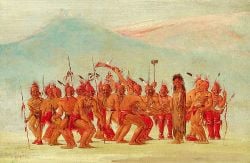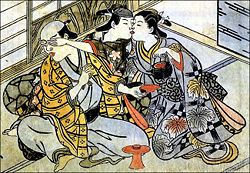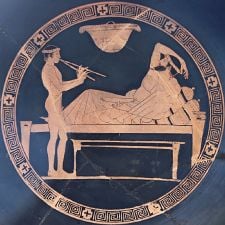Bisexuality
 From Nwe
From Nwe 
Bisexuality is a sexual orientation which refers to the romantic, and/or sexual attraction of individuals to other individuals of both their own and the opposite gender or sex. Most bisexuals are not equally attracted to men and women, and may even shift between states of finding either sex exclusively attractive over the course of time. However, some bisexuals are and remain fairly stable in their level of attraction throughout their adult life.
While it appears that throughout history people have commonly indulged in sexual behavior with members of both the same and opposite sex, the issue of whether bisexuality as a state distinct from heterosexuality and homosexuality is unresolved. For some, this third "orientation" is as valid as attraction to a single sex. For others, it constitutes experimentation, or a transition stage in "coming out" as homosexual. Some argue that even though many may act on their attraction to both sexes that does not constitute a separate class of people. Another interpretation is that all people are searching for sexual satisfaction, and that search may take them on many paths before they find true love.
Terminology
The term bisexual was first used in the nineteenth century to refer to hermaphroditic species—those having both male and female reproductive organs.[1] Following the publication of Richard von Krafft-Ebing's Psychopathia Sexualis in 1886 (in German) the term began to be used in the context of sexual orientation.[2] Some bisexuals and sex researchers are dissatisfied with the term, and have developed a variety of alternative or supplementary terms to describe aspects and forms of bisexuality. Many are neologisms not widely recognized by the larger society. The various terms reflect some people's attractions to all people (versus the traditional male-female dichotomy), one's openness to, if not expressed desire for, sexual relations with a given gender, or one's curiosity in exploring one's sexuality. Because bisexuality is often an ambiguous position between homosexuality and heterosexuality, those who identify, or are identified, as bisexuals form a heterogeneous group.
In the mid-1950s, Alfred Kinsey devised the "Kinsey scale" in an attempt to measure sexual orientation. The 7 point scale has a rating of 0 ("exclusively heterosexual") to 6 ("exclusively homosexual"). Bisexuals cover most of the scales' values (1–5) which ranges between "predominantly heterosexual, only incidentally homosexual" (1) to "predominantly homosexual, only incidentally heterosexual" (5). In the middle of the scale (3) is "equally heterosexual and homosexual."
Bisexuality is now considered a distinct sexual orientation on par with heterosexuality or homosexuality.[3]
The classification of bisexuality may be somewhat ambiguous. Some people who might be classified by others as bisexual on the basis of their sexual behavior self-identify primarily as homosexual. Equally, otherwise heterosexual people who engage in occasional homosexual behavior could be considered bisexual, but may not identify as such. For some who believe that sexuality is a distinctly defined aspect of the character, this ambiguity is problematic. It has been suggested that the behavior of bisexuals may be explained by a subconscious homophobia or peer pressure.
Bisexuals are often associated with men who engage in same-sex activity while "closeted" or heterosexually married. However, the majority of such men do not self-identify as bisexual.
Bisexuality is often misunderstood as a form of adultery or polyamory, and a popular misconception is that bisexuals must always be in relationships with men and women simultaneously. Rather, individuals attracted to both males and females may live a variety of sexual lifestyles. These include: Lifelong monogamy, serial monogamy, polyamory, polyfidelity, casual sexual activity with individual partners, casual group sex, and celibacy. For those with more than one sexual partner, these may or may not be of the same gender.
History

In some cultures, historical and literary records indicate that male bisexuality was common and indeed expected. These relationships were generally age-structured (as in the practice of pederasty in the Mediterranean Basin of antiquity, or the practice of shudo in pre-modern Japan) or gender-structured (as in the Two-Spirit North American tradition or the Central Asian bacchá practices).
Bisexual behavior appears to have been common among Roman and Chinese emperors, the shoguns of Japan, and others. It is documented that the Roman emperor Hadrian met Antinous, a 13 or 14 year old boy from Bithynia, in 124 C.E. and they began a pederastic relationship. Antinous was deified by Hadrian, when he died six years later. Many statues, busts, coins, and reliefs display Hadrian's deep affections for him. Ancient Rome, Arab countries up to and including the present, China, and Japan, all exhibit patterns of analogous bisexual behavior. In Japan in particular, due to its practice of shudo and the extensive art and literature associated with it, the record of a primarily bisexual lifestyle is both detailed and quite recent, dating back as recently as the nineteenth century.
Male heterosexuality and homosexuality, while also documented, appear mostly as exceptions, unless in examining cultures influenced by the Abrahamic religions, where heterosexuality was privileged, and bisexuality and homosexuality forcefully suppressed. In fact, most of the commonly cited examples of male "homosexuality" in previous cultures would more properly be categorized as bisexuality. Determining the history of female bisexuality is more problematic, in that women in most of the studied societies were under the domination of the males, and on one hand had less self-determination and freedom of movement and expression, and on the other were generally not the ones writing or keeping the literary record.
It should be noted that the terms "heterosexual," "bisexual," "homosexual," and the concept of "sexual orientation" itself are all modern sociological constructs, and may not be appropriate in historical contexts, in which "behavior" might be considered homosexual, but people were not labeled using such terms.
Ancient Greece

Ancient Greek religious texts, reflecting cultural practices, incorporated bisexual themes. The subtexts varied, from the mystical to the didactic.[4]
Ancestral law in ancient Sparta mandated same-sex relationships with youths who were coming of age for all adult men, so long as the men eventually took wives and produced children. The Spartans thought that love and erotic relationships between experienced and novice soldiers would solidify combat loyalty and encourage heroic tactics as men vied to impress their lovers. Once the younger soldiers reached maturity, the relationship was supposed to become non-sexual, but it is not clear how strictly this was followed. There was some stigma attached to young men who continued their relationships with their mentors into adulthood. For example, Aristophanes calls them euryprôktoi, meaning "wide arses," and depicts them like women.[4]
In Ancient Greece, it is believed that males generally went through a homosexual stage in adolescence, followed by a bisexual stage characterized by pederastic relationships in young adulthood, followed by a (mostly) heterosexual stage later in life, when they married and had children. Alexander the Great, the Macedonian king, is thought to have been bisexual, and to have had a male lover named Hephaestion.[5]
Modern Western culture

Sigmund Freud theorized that every person has the ability to become bisexual at some time in his or her life.[6] He based this on the idea that enjoyable experiences of sexuality with the same gender, whether sought or unsought, acted on or being fantasized, become an attachment to his or her needs and desires.
Some studies, notably Alfred Kinsey's Sexual Behavior in the Human Male (1948) and Sexual Behavior in the Human Female (1953), indicated that the majority of people appear to be at least somewhat bisexual. The studies reported that most people have some attraction to either sex, although usually one sex is preferred. However, later reports indicate a much different picture.
The Janus Report on Sexual Behavior, published in 1993, showed that 5 percent of men and 3 percent of women consider themselves bisexual and 4 percent of men and 2 percent of women considered themselves homosexual.[7]
Some studies, including one by controversial researcher J. Michael Bailey which attracted media attention in 2005, purported to find that bisexuality is extremely rare in men, but such studies have typically worked from the assumption that a person is only truly bisexual if he or she exhibits virtually equal arousal responses to both opposite-sex and same-sex stimuli, and have consequently dismissed the self-identification of people whose arousal patterns showed even a mild preference for one sex.[8]
Despite common misconceptions, bisexuality does not require that a person is attracted equally to both sexes. In fact, people who have a distinct but not exclusive preference for one sex over the other can and often do identify as bisexual.
Social status of bisexuality

Historically, bisexuality has largely been free of the social stigma associated with homosexuality, prevalent even where bisexuality was the norm. In Ancient Greece, pederasty was not problematic as long as the men involved eventually married and had children. In many world cultures, homosexual affairs have been quietly accepted among upper-class men of good social standing (particularly if married), and heterosexual marriage has often been used successfully as a defense against accusations of homosexuality. On the other hand, there are bisexuals who marry or live with a heterosexual partner because they prefer the complementarity of different genders in cohabiting and co-parenting, but have felt greatly enriched by homosexual relationships alongside the marriage in both monogamous and "open" relationships.
Some in the gay and lesbian communities accuse those who self-identify as bisexual of duplicity, believing they are really homosexuals who engage in heterosexual acts merely to remain socially acceptable. They may be accused of "not doing their part" in gaining acceptance of "true" homosexuality. Some gay and lesbian people may also suspect that a self-described bisexual is merely a homosexual in the initial stage of questioning their presumed heterosexuality, and will eventually accept that they are lesbian or gay; this is expressed by a glib saying in gay culture: "Bi now, gay later." These situations can and do take place, but do not appear to be true of the majority of self-described bisexuals. Nonetheless, bisexuals do sometimes experience lesser acceptance from gay and lesbian people, because of their declared orientation.
Because some bisexual people do not feel that they fit into either the gay and lesbian or the heterosexual world, and because they have a tendency to be "invisible" in public, some bisexual persons are committed to forming their own communities, culture, and political movements. However, since bisexual orientation can fall anywhere between the two extremes of homosexuality and heterosexuality, some who identify as bisexual may merge themselves into either homosexual or heterosexual society.
Psychologist Beth Firestein has stated that bisexuals also tend to internalize social tensions related to their choice of partners.[9] Firestein suggests bisexuals may feel pressured to label themselves as either gays or lesbians instead of occupying a difficult middle ground in a culture that has it that if bisexuals are attracted to people of both sexes, they must have more than one partner, thus defying society's value on monogamy.
Bisexuality in animals
Many non-human animal species also exhibit bisexual behavior. This is, of course, common in hermaphroditic animals, but is also known in many other species. Among invertebrates, structural and behavioral bisexuality is quite common. And among fish and other lower vertebrates the combination is also not uncommon. For mammals, however, and humans in particular, the situation is less clear.
Hermaphroditism or structural bisexuality becomes rare higher in the evolutionary scale. Some examples, however, do exist. The common domestic cow has a well-known condition known as Freemartin, in which a female Bovine fetus, while in utero with a male twin, becomes "masculinized" by the gestational androgens present. These are sufficient to modify both her internal and external genitals. These females are almost always sterile and demonstrate male like behaviors. Even among normal cows, female-female mounting may occur when one is in estrus. This is regarded as a sexual mount, not a displacement activity in the absence of a male. However, if a bull were present he would mount the female and female-female mounting would be less likely to occur.[10]
Primates in the wild seem predominantly, if not exclusively, heterosexual and are not hermaphroditic. Male-male and female-female mounting is not uncommon, but it is almost always a demonstration of dominance or status in the social hierarchy, or a substitute behavior such as in the young or adults who have no partner. Rarely does any activity occur which might be considered preferentially homosexual. The Bonobo (a chimpanzee-like primate) evidences occasions of same-sex behaviors which can be considered mutual masturbation, kissing, genital play, and genital apposition. However, these behaviors have been interpreted as serving tension-regulating rather than erotic functions.
In all of these nonhuman mammalian situations it appears that homosexual or bisexual activities occur only when there is present both a stimulus by one type of partner and the absence of another type, and with certain individuals. This means both that the environmental situation must be conducive to the behavior and that only certain individuals and certain species will respond.
Notes
- ↑ Bisexuality Etymology online. Retrieved December 23, 2020.
- ↑ Richard von Krafft-Ebing, Psychopathia Sexualis: The Classic Study of Deviant Sex (Arcade, 2011, ISBN 978-1611450507).
- ↑ Bisexuality - the least common and most misunderstood of the three sexual orientations Religious Tolerance. Retrieved December 23, 2020.
- ↑ 4.0 4.1 Hein van Dolen, Greek Homosexuality Livius. Retrieved December 23, 2020.
- ↑ Alexander the Great Hostory.com. Retrieved December 23, 2020.
- ↑ Sigmund Freud, Three Contributions to the Theory of Sex (Dover Publications, 2001, ISBN 978-0486416038).
- ↑ Samuel S. Janus and Cynthia L. Janus, The Janus Report on Sexual Behavior (Wiley, 1994, ISBN 978-0471016144).
- ↑ Benedict Carey, Straight, Gay or Lying? Bisexuality Revisited The New York Times, July 5, 2005. Retrieved December 23, 2020.
- ↑ Tori DeAngelis, A new generation of issues for LGBT clients Monitor on Psychology, 33(2) (February 2002): 42. Retrieved December 23, 2020.
- ↑ Milton Diamond, Bisexuality: A Biological Perspective Pacific Center for Sex and Society, July 14, 1990. Retrieved December 23, 2020.
References
ISBN links support NWE through referral fees
- Burleson, William E. Bi America: Myths, Truths, And Struggles Of An Invisible Community. ISBN 978-1560234784
- Crompton, Louis. Homosexuality and Civilization. London, 2003. ISBN 067401197X
- Dover, Kenneth J. Greek Homosexuality. New York: Vintage Books, 1978. ISBN 0394742249
- Firestein, Beth A. Bisexuality: The Psychology and Politics of an Invisible Minority. 1978. ISBN 0803972741
- Fox, Ronald C. Current Research on Bisexuality. ISBN 978-1560232885
- Freud, Sigmund. Three Contributions to the Theory of Sex. Dover Publications, 2001. ISBN 978-0486416038
- Hubbard, Thomas K. Homosexuality in Greece and Rome. U. of California Press, 2003. ISBN 0520234308
- Hutchins, Loraine & Lani Ka'ahumanu. Bi Any Other Name: Bisexual People Speak Out. ISBN 1555831745
- Janus, Samuel S., and Cynthia L. Janus. The Janus Report on Sexual Behavior. Wiley, 1994. ISBN 978-0471016144
- Klein, Fritz. The Bisexual Option. ISBN 1560230339
- Larivière, Michel. Homosexuels et bisexuels célèbres. Delétraz Editions, 1997. ISBN 2911110196
- Leupp, Gary. Male Colors: The Construction of Homosexuality in Tokugawa Japan. Berkeley: University of California Press, 1995. ISBN 0520209001
- Murray, Stephen O. & Will Roscoe. Islamic Homosexualities: Culture, History, and Literature. New York: New York University Press, 1997. ISBN 0814774687
- Ochs, Robyn & Sarah Rowley. Getting Bi: Voices of Bisexuals Around the World. ISBN 096538814X
- Percy, W.A. III. Pederasty and Pedagogy in Archaic Greece. University of Illinois Press, 1996. ISBN 0252022092
- Rodriguez Rust, Paula C. Bisexuality in the United States: A Social Science Reader. ISBN 0231102267
- Suresha, Ron & Pete Chvany. Bi Men: Coming Out Every Which Way. ISBN 978-1560236159
- von Krafft-Ebing, Richard. Psychopathia Sexualis: The Classic Study of Deviant Sex. Arcade, 2011. ISBN 978-1611450507
- Watanabe, Tsuneo & Jun'ichi Iwata. The Love of the Samurai. A Thousand Years of Japanese Homosexuality. London: GMP Publishers, 1987. ISBN 0854491155
- Wright, J. & Everett Rowson. Homoeroticism in Classical Arabic Literature. 1998.
External links
All links retrieved February 3, 2022.
- Understanding Bisexuality American Psychological Association
- What Does It Mean to Be Bi or Bisexual? Healthline
- The evolution of the word 'bisexual' — and why it's still misunderstood
Credits
New World Encyclopedia writers and editors rewrote and completed the Wikipedia article in accordance with New World Encyclopedia standards. This article abides by terms of the Creative Commons CC-by-sa 3.0 License (CC-by-sa), which may be used and disseminated with proper attribution. Credit is due under the terms of this license that can reference both the New World Encyclopedia contributors and the selfless volunteer contributors of the Wikimedia Foundation. To cite this article click here for a list of acceptable citing formats.The history of earlier contributions by wikipedians is accessible to researchers here:
- Bisexuality history
The history of this article since it was imported to New World Encyclopedia:
- History of "Bisexuality"
Note: Some restrictions may apply to use of individual images which are separately licensed.
↧ Download as ZWI file | Last modified: 02/04/2023 09:00:24 | 68 views
☰ Source: https://www.newworldencyclopedia.org/entry/Bisexual | License: CC BY-SA 3.0
 ZWI signed:
ZWI signed: KSF
KSF